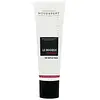What's inside
What's inside
 Key Ingredients
Key Ingredients

 Benefits
Benefits

 Concerns
Concerns

 Ingredients Side-by-side
Ingredients Side-by-side

Water
Skin ConditioningHelianthus Annuus Seed Oil
EmollientBehenyl Alcohol
EmollientButylene Glycol
HumectantC10-18 Triglycerides
EmollientGlycerin
HumectantButyrospermum Parkii Butter
Skin ConditioningGarcinia Indica Seed Butter
Skin ConditioningSimmondsia Chinensis Seed Oil
EmollientGlyceryl Stearate
EmollientCaprylic/Capric Triglyceride
MaskingParfum
MaskingArginine
MaskingHydroxystearic/Linolenic/Oleic Polyglycerides
EmollientTrehalose
HumectantCetearyl Alcohol
EmollientSodium Stearoyl Lactylate
EmulsifyingMicrocrystalline Cellulose
AbsorbentGlyceryl Caprylate
EmollientAloe Barbadensis Leaf Juice
Skin ConditioningTocopherol
AntioxidantBisabolol
MaskingGalactaric Acid
Laminaria Ochroleuca Extract
Skin ConditioningXimenia Americana Seed Oil
EmollientBiosaccharide Gum-2
Skin ConditioningCellulose Gum
Emulsion StabilisingSodium Hyaluronate
HumectantSclerotium Gum
Emulsion StabilisingXanthan Gum
EmulsifyingPhytic Acid
Commiphora Mukul Resin Extract
Skin ConditioningOenothera Biennis Seed Extract
Skin ConditioningBrassica Oleracea Italica Extract
AstringentCamellia Sinensis Leaf Extract
AntimicrobialPunica Granatum Fruit Extract
AntioxidantSilybum Marianum Extract
Skin ConditioningRosmarinus Officinalis Leaf Extract
AntimicrobialWater, Helianthus Annuus Seed Oil, Behenyl Alcohol, Butylene Glycol, C10-18 Triglycerides, Glycerin, Butyrospermum Parkii Butter, Garcinia Indica Seed Butter, Simmondsia Chinensis Seed Oil, Glyceryl Stearate, Caprylic/Capric Triglyceride, Parfum, Arginine, Hydroxystearic/Linolenic/Oleic Polyglycerides, Trehalose, Cetearyl Alcohol, Sodium Stearoyl Lactylate, Microcrystalline Cellulose, Glyceryl Caprylate, Aloe Barbadensis Leaf Juice, Tocopherol, Bisabolol, Galactaric Acid, Laminaria Ochroleuca Extract, Ximenia Americana Seed Oil, Biosaccharide Gum-2, Cellulose Gum, Sodium Hyaluronate, Sclerotium Gum, Xanthan Gum, Phytic Acid, Commiphora Mukul Resin Extract, Oenothera Biennis Seed Extract, Brassica Oleracea Italica Extract, Camellia Sinensis Leaf Extract, Punica Granatum Fruit Extract, Silybum Marianum Extract, Rosmarinus Officinalis Leaf Extract
Oryza Sativa Extract
AbsorbentButylene Glycol
HumectantGlycerin
HumectantHelianthus Annuus Seed Oil
EmollientBetaine
HumectantNiacinamide
SmoothingDimethicone
Emollient1,2-Hexanediol
Skin ConditioningCetearyl Olivate
Sorbitan Olivate
EmulsifyingElaeis Guineensis Oil
EmollientElaeis Guineensis Kernel Oil
EmollientHydroxyethyl Acrylate/Sodium Acryloyldimethyl Taurate Copolymer
Emulsion StabilisingCetearyl Alcohol
EmollientEthylhexylglycerin
Skin ConditioningArginine
MaskingCarbomer
Emulsion StabilisingAllantoin
Skin ConditioningXanthan Gum
EmulsifyingOryza Sativa Extract, Butylene Glycol, Glycerin, Helianthus Annuus Seed Oil, Betaine, Niacinamide, Dimethicone, 1,2-Hexanediol, Cetearyl Olivate, Sorbitan Olivate, Elaeis Guineensis Oil, Elaeis Guineensis Kernel Oil, Hydroxyethyl Acrylate/Sodium Acryloyldimethyl Taurate Copolymer, Cetearyl Alcohol, Ethylhexylglycerin, Arginine, Carbomer, Allantoin, Xanthan Gum
 Reviews
Reviews

Ingredients Explained
These ingredients are found in both products.
Ingredients higher up in an ingredient list are typically present in a larger amount.
Arginine is an amino acid that is important for human development. Your body uses is it to produce hair keratin and skin collagen.
As a cosmetic ingredient, Arginine has antioxidant properties and can also help repair damaged skin. This ingredient is derived either synthetically or from animals.
Arginine isn't fungal acne safe when used in the presence of other lipids (fats, fatty acids, oils, esters, etc). Oils and fats occur naturally within the skin, so take caution when using Arginine if you're prone to fungal acne.
Learn more about ArginineButylene Glycol (or BG) is used within cosmetic products for a few different reasons:
Overall, Butylene Glycol is a safe and well-rounded ingredient that works well with other ingredients.
Though this ingredient works well with most skin types, some people with sensitive skin may experience a reaction such as allergic rashes, closed comedones, or itchiness.
Learn more about Butylene GlycolCetearyl alcohol is a mixture of two fatty alcohols: cetyl alcohol and stearyl alcohol. It is mainly used as an emulsifier. Emulsifiers help prevent the separation of oils and products. Due to its composition, it can also be used to thicken a product or help create foam.
Cetearyl alcohol is an emollient. Emollients help soothe and hydrate the skin by trapping moisture.
Studies show Cetearyl alcohol is non-toxic and non-irritating. The FDA allows products labeled "alcohol-free" to have fatty alcohols.
This ingredient is usually derived from plant oils such as palm, vegetable, or coconut oils. There is debate on whether this ingredient will cause acne.
Due to the fatty acid base, this ingredient may not be Malassezia folliculitis safe.
Learn more about Cetearyl AlcoholGlycerin is already naturally found in your skin. It helps moisturize and protect your skin.
A study from 2016 found glycerin to be more effective as a humectant than AHAs and hyaluronic acid.
As a humectant, it helps the skin stay hydrated by pulling moisture to your skin. The low molecular weight of glycerin allows it to pull moisture into the deeper layers of your skin.
Hydrated skin improves your skin barrier; Your skin barrier helps protect against irritants and bacteria.
Glycerin has also been found to have antimicrobial and antiviral properties. Due to these properties, glycerin is often used in wound and burn treatments.
In cosmetics, glycerin is usually derived from plants such as soybean or palm. However, it can also be sourced from animals, such as tallow or animal fat.
This ingredient is organic, colorless, odorless, and non-toxic.
Glycerin is the name for this ingredient in American English. British English uses Glycerol/Glycerine.
Learn more about GlycerinHelianthus Annuus Seed Oil is the oil derived from the seeds of a Sunflower. Sunflower seed oil is non-fragrant. It is an emollient, meaning it helps to soften the skin.
Sunflower seed oil contains many fatty acids. The fatty acids found in sunflower seeds include (from highest amount to least): linoleic acid, myristic acid, palmitic acid, stearic acid, arachidic acid, oleic acid, and linolenic acid.
These fatty acids help the skin create ceramides. Ceramides play a role in repairing the skin barrier.
Helianthus Annuus Seed Oil helps moisturize the skin. This in turn helps the skin look more rejuvenated and smoother.
Sunflowers are rich in vitamin E.
Historians believe Indigenous cultures of North America domesticated sunflowers before corn. Thus they relied on sunflower oil for a variety of uses. One such use is moisturizing skin and hair.
Sunflower seed oil may not be fungal acne safe. We recommend speaking with a professional if you have any concerns.
Learn more about Helianthus Annuus Seed OilXanthan gum is used as a stabilizer and thickener within cosmetic products. It helps give products a sticky, thick feeling - preventing them from being too runny.
On the technical side of things, xanthan gum is a polysaccharide - a combination consisting of multiple sugar molecules bonded together.
Xanthan gum is a pretty common and great ingredient. It is a natural, non-toxic, non-irritating ingredient that is also commonly used in food products.
Learn more about Xanthan Gum